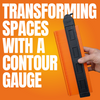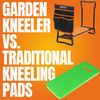
Laminate flooring has become an increasingly popular option among homeowners due to its affordability, durability, and ease of installation. But if you're thinking of taking on the laminate installation yourself, you may be wondering what tools you should have on hand.
In this beginners friendly DIY guide, we'll explore the essential tools you'll need to lay laminate flooring. From measuring and cutting to laying and fitting the flooring, we'll walk you through step-by-step and give you the confidence you need to tackle this project like a pro. So, let's get started on creating the perfect floors for your home!
Benefits of Installing Laminate Flooring
Laminate flooring offers several benefits, including durability, low maintenance, and affordability. It is also available in a variety of styles and colors, making it easy to find a design that suits your aesthetic preferences.
Laminate flooring is a floating floor material that isn't attached to the subfloor or underlayment. When installed properly, laminate flooring can last up to 20 years or more because they are extremely durable, which means they will last much longer than other types of flooring. Not only is laminate flooring affordable and durable, but it's also resistant to scratching and staining.
This makes it an excellent option for high-traffic areas, homes with pets or children, and those who want a floor that requires minimal maintenance. With laminate flooring, you can enjoy beautiful floors without having to constantly worry about scratches, stains, or other types of damage.

In addition to being scratch and stain-resistant, laminate flooring is also water-resistant. This makes it a great choice for areas of your home that are prone to moisture or spills, such as bathrooms or kitchens. However, it's important to note that laminate flooring is not completely waterproof, and excessive exposure to water can still cause damage.
Laminate flooring offers a wide range of colors and styles to choose from, making it easy to find the perfect fit for your home. Whether you prefer a rustic natural wood look or something more modern and sleek, there is a laminate option that will suit your taste. Plus, with advancements in technology, laminate flooring can now mimic the look and texture of hardwood or even stone without the high cost or maintenance.
Cost Savings Over Time
The laminate flooring installation cost savings are significant when you consider how long it will last. It is a cost-effective alternative to solid hardwood floors, as it is more durable and easier to maintain. The manufacturing process for laminate flooring uses fewer materials than traditional wood floors, which results in lower overall costs. Also, laminate flooring can be installed much faster than hardwood giving yet another cost savings due to the labor involved with the installation of a new wood floor.

If you have laminate flooring installed today, it won’t need to be replaced for many years, saving you money on repairs and replacements in the future. Additionally, laminate flooring is easy to clean and maintain, which means you won't need to spend as much time and money on upkeep compared to other types of flooring.
7 Essential Tools for Laminate Flooring Installation
Now, let's talk about the tools you will need to lay laminate flooring. You will need the following basic tools:
1. Measuring tape
Measuring tape to accurately measures the room so that you know how much laminate flooring to purchase and cut. It also helps ensure that all of the planks are aligned correctly, as even a slight misalignment can affect the look of your floors. Additionally, measuring tape is needed for other parts of the installation such as drawing cutting lines across planks or marking locations for underlayment.
2. Pencil
In order to complete the installation of laminate flooring correctly, a pencil is essential for marking and cutting the planks during the installation. It can be used to draw straight lines on each plank before it is cut in order to ensure that all pieces are connected properly when installed. A carpenter's pencil or “lay-out” type with lead specifically designed for woodworking will lay down a light but distinct line which will help guide your saw blade when making cuts.
3. T-square
It allows the installer to make precise and accurate cuts at 90-degree angles. The T-square also helps with marking measurements, making sure that all pieces of the laminate fit together properly and accurately. Without a T-square, installing laminate flooring can be difficult and lead to inaccurate results or gaps in the finished project.
4. Hammer
A hammer is used to secure the planks in place. Laminate flooring can be installed using a floating floor method, where the planks are not glued or nailed down to the subfloor. In this case, a hammer and tapping block are used to gently tap the planks together along their edges, creating a tight and secure fit.
5. Tapping block
A tapping block is essential for laminate flooring installation because it helps to evenly distribute the force of hammer blows when tapping planks together. It ensures that boards are joined firmly without causing any damage or warping. The block also protects the tongue and groove from getting chipped or cracked during installation, providing a better finish overall.
6. Flooring pull bar
A flooring pull bar helps the planks of laminate stay together while they are being tapped into place. The metal pull bar essentially squeezes the plank down flat against its neighbor, keeping them tightly fitted and reducing any chance of gaps or slippage. This is especially important for floating floors that rely on tight joins between adjacent boards to remain stable under foot traffic and other stressors in the home environment.
7. Moisture barrier
A moisture barrier is essential for laminate flooring installation because it helps protect the subfloor and the laminate planks from moisture damage. The moisture barrier acts as a shield by preventing water vapor or liquid water from coming into contact with the structure of your home, like wood floors or drywall. This can help prevent warping, buckling, cupping, and other types of damage that moisture can cause over time.
Other important tools include a pry bar, to remove any existing flooring, a rubber mallet, to fit each laminate plank into place, and a tapping block, to ensure that each plank is properly locked into place. Additionally, a leveling tool, utility knife, and spacers will be necessary to ensure that the floor is level and the planks are evenly spaced.
Another innovative tool perfect for shape copying that will surely help you with the door edges when installing a floor lamination is the SuperGauge.

This handy tool allows you to easily copy the shape of any door or cabinet edge, so you can cut your planks to the exact size and shape needed. With the SuperGauge, you'll be able to achieve a flawless installation with minimal effort and no guesswork. So add it to your list of must-have tools, and get ready to lay your laminate flooring like a pro.
It is important to note that some tools like jigsaw, square jamb saw, circular saw, and miter saw may vary depending on the specific installation method and the type of laminate flooring you choose. Always refer to the manufacturer's instructions and consult with a professional if you are unsure of which tools to use.
Laying Laminate Flooring - A Step-by-Step DIY Guide
Before you can install your new floor, you will need to acclimate at least 48 hours before installation. You'll also need to leave about a 1/4 to 3/8 inch gap (as directed by the manufacturer) of space between the boards and the wall to allow for expansion gap and contraction of the flooring over time.

Unlike ceramic tile, laminate flooring installation is dry—no grout, no mortar, and no adhesives that are set up while you're working. You can often install laminate over old floor coverings like sheet vinyl as long as it’s flat, smooth, and not too soft.
Once you have gathered all the essential tools and materials, it's time to start the installation process.
1. Clean the floor and remove any furniture or rugs of the old flooring.
You may relocate everything to one side of the room, lay half of the flooring, and then relocate the furniture on the new layer as you continue laying layers across the room for bigger rooms.
2. Measure the room so that you know how many pieces of laminate to purchase.
To determine the square footage of the space, first, measure the span of the space and the width of the room with a measuring tape. If a subfloor is present, remove it before installing the laminate flooring.
3. Install the moisture or vapor barrier.
Lay down an underlayment of a moisture barrier or foam padding according to the laminate flooring's instructions (skip if installing over hardwood).
4. Laying the planks.
Before laying out your flooring planks, familiarize yourself with the room layout so you understand which direction each plank should be installed in (most rooms require that all planks run in one continuous line). It is always a good idea to snap a chalk line where the groove edge is going to be on the first row. Secure the first plank to the floor using a hammer and nails, starting at one corner of the room. Use the T-square to make precise cuts with the flooring planks. Do not forget to use spacers to ensure even spacing between planks.
Continue to lay planks along the first row with the tongue side until it’s complete, make sure they are locked together tightly by pressing down firmly on them with your hands or tapping them into place with a tapping block as you go. Staggering the seams in each row helps create a more secure installation. However, don't use excessive force - laminate plank flooring can be easily damaged if forced too hard into place!

When laying each new plank in subsequent rows, stagger their placement so they don’t line up exactly like the ones before them. This will give your floor a more natural and attractive look.
5. Once the floor is complete, remove all spacers and install any trim or molding as necessary.
Installing the last plank might be a challenge for you. To make sure that the board is flush, trim any excess material. Install thresholds at every entrance, or wherever the laminate meets another flooring material.
Remember to always read and follow the manufacturer's instructions carefully, and seek assistance from a professional if you are unsure about anything in the process.
Conclusion
Installing laminate flooring is a great DIY project that can be done relatively quickly and with minimal tools. All of the items listed above are necessary to get started, but depending on the details of what you’re attempting to do there may be other specialty tools or supplies needed for your job. Be sure to plan out the room carefully, considering the layout and any obstacles you may encounter. Take your time with each step and always pay attention to detail to ensure a beautiful and long-lasting result. With the proper tools, materials, and instructions by your side, you'll be well on your way to a successful laminate floor installation!
























